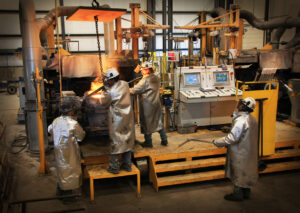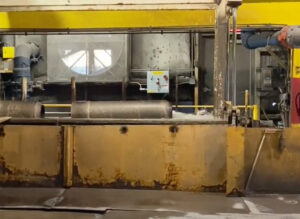The 8620 material grade is popular in tube part designs and is usually viewed as only a commodity. But what if there was an equivalent metal produced using a different process that could manufacture a better tube product?
Below you’ll learn how an 8620 equivalent can live up to (and may even surpass) the original metal. You’ll also see how the centrifugal casting method makes it all possible.
Defining an 8620 steel grade
The 8620 forged steel grade is common for industrial use and is regarded as low alloy steel. It’s often sold in the form of round bars and offers a combination of toughness and wear resistance along with good internal and even greater external strength.
Upgrading your part for less with an alternative metal and method
“13Q” is an 8620 equivalent that is produced by the Spuncast Centrifugal Foundry. (“13Q” is the ASTM grade name). It may be more than an “equivalent” — it may actually be superior because it is manufactured using the centrifugal casting method.
Centrifugal casting improves the physical properties of most metals used in a tubular design. Once cast, the “13Q” offers an equivalent and often superior performance than the commonly used forged metal.
But, it takes reviewing the chemical composition and the mechanical properties of the two metals to offer a fair comparison. It also means an examination of the centrifugal process and the improved microstructural characteristics resulting from the metal treatments common to the method.
There is also no material waste because of the one-piece, hollow construction of the centrifugal casting method, so production costs are often lower.

Comparing the alternative to the original
Chemical properties
There is only a slight difference in the chemical make-up of the Spuncast “13Q” compared to the 8620.
Below, you see the chemical properties of the AISI 8620.
| AISI 8620 Forged Steel | |
| Carbon max | .18 – .23 |
| Magnesium max | .7 – .9 |
| Silicon max | .15 – .35 |
| Phosphorus max | 0.035 |
| Sulfur max | 0.04 |
| Nickel | .40 – .70 |
| Molybdenum | .15 – .25 |
| Other max | – |
Now, look at the Spuncast Alloy “13Q.” It contains equivalent elements to the 8620 and adds copper and tungsten for improved hardness and heat resistance.
| Spuncast Alloy “13Q” | |
| Carbon max | .15 – .25 |
| Magnesium max | .65 – .95 |
| Silicon max | .20 – .80 |
| Phosphorus max | 0.04 |
| Sulfur max | 0.05 |
| Nickel | .40 – .70 |
| Molybdenum | .15 – .25 |
| Other max | Cu .50 W .10 |
Mechanical properties
Comparing the mechanical properties of each material shows the tensile strength, yield strength, elongation, hardness, and density are very similar.
The original 8620 contains good toughness and strength properties, along with good core strength.
| AISI 8620 Forged Steel | |
| Tensile (min) – KSI (MPa) | 92 (633) |
| Yield (min) – KSI (MPa) | 52 (357) |
| Elongation (2″ min) | 13% |
| Brinell Hardness (10mm – 3000Kg -) Typical Values | 150 – 210 |
| Density lbs/in | 0.284 |
The 8620 equivalent also has good toughness and strength and can be further improved with additional metal treatments.
| Spuncast Alloy “13Q” | |
| Tensile (min) – KSI (MPa) | 105 (724) |
| Yield (min) – KSI (MPa) | 85 (586) |
| Elongation (2″ min) | 10% |
| Brinell Hardness (10mm – 3000Kg -) Typical Values | 197 – 262 |
| Density lbs/in | 0.28 |
Further improving physical properties with metal treatments
The properties of the “13Q” show it’s a strong material that can readily undergo secondary processing. Two typical treatments that boost the physical properties of the metal are
1. Heat treating – extends the life of the tubing component by improving the metal’s physical properties with a controlled heating and cooling process.
2. CNC machining – eliminates process variation by removing large amounts of metal fast and selectively removing an exact amount for a near-final shape.
Because it offers a reliably stronger, tougher result after processing, it can be used for components that consider safety a priority like
- Industrial drives and engines
- Mill and mining equipment
- Automotive gears and transmissions
- Aircraft mechanical and structural parts

Working with a centrifugal foundry
Designing a tubing component using an 8620 equivalent like the “13Q” is a multi-step process requiring diversified expertise. Working closely with a dedicated centrifugal casting foundry will ensure you get a better product and better lead times.
With over 45 years of experience, Spuncast can help through every stage of that process, from selecting the best material to choosing secondary processes.

